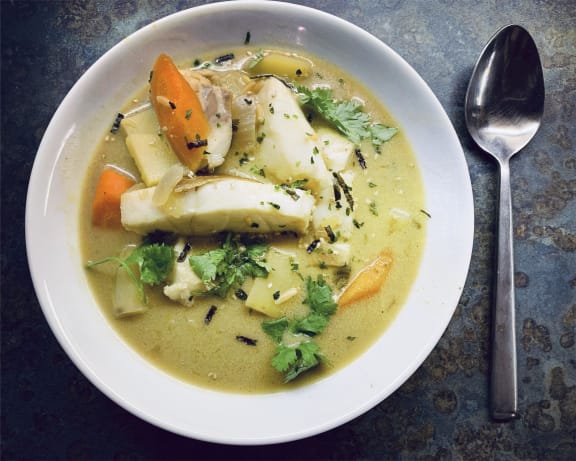As a gentle cooking method, poaching is a great way to enhance the delicate qualities of any fish — even a meaty species like Pacific halibut. Poaching Pacific halibut transforms this white fish into a moist, flaky fillet every time.
Poaching is a great cooking method for beginners, since Pacific halibut can be dry when overcooked. The gentle heat and added moisture help to keep the fish tender, similar to what happens when you steam Pacific halibut. But poaching is also a good cooking method for more experienced home cooks who want to explore all the culinary possibilities that poaching offers.
Ingredients for Poaching Pacific Halibut
The main elements required for poaching Pacific halibut, or any fish, are a poaching liquid, flavorful aromatic ingredients, and sometimes a dash of acidity to help the poaching liquid meld with the aromatics.
Pacific halibut can also be poached in a fat like butter or olive oil, though this technique differs from the classic poach discussed here.
Poaching Liquid Options
The poaching liquid is what gently transfers the heat from your stovetop to the fillet of Pacific halibut. You’ll need to use enough poaching liquid to submerge the fillets of Pacific halibut. It helps to use a smaller pot or saucepan, since you won’t need to use as much liquid to ensure that the fish can be fully submerged.
You have a wide range of options to choose from, whether something more brothy or creamy.
-
Veggie or spot prawn stock: Either of these will impart a neutral flavor to the dish.
-
Crushed tomatoes: Crushed tomatoes will give you a saucy poaching liquid that you can spoon over the fish for serving.
-
Coconut milk: Coconut milk is a great base for Caribbean or Thai inspired dishes. The fats in coconut milk also help to keep lean Pacific halibut extra moist.
-
Milk or half-and-half: The fats in dairy also help to produce moist fillets of poached fish. Milk is a bit more delicate, while half-and-half will give you creamier results.
-
Water, seasoned with soy sauce or miso paste: While plain water can be used as the base for a poaching liquid, a splash of soy sauce or bit of miso paste whisked in enhances the dish with extra umami.
Add Flavorful Ingredients
Add complexity to the poaching liquid with herbs, spices, and other flavorful ingredients. This is where you can get creative by building different flavor profiles through different combinations of ingredients.
Here are some ideas for what to put in your poaching liquid:
-
For a French flavor profile: A few sprigs of thyme, black peppercorns, bay leaves, a small chunk of fennel bulb.
-
For a Southeast Asian flavor profile: A coin of fresh ginger, a clove of smashed garlic, a piece of lemongrass.
-
For a Japanese flavor profile: Dried shiitake mushrooms, scallions, and a piece of carrot.
-
For a Latin flavor profile: A bay leaf, a chunk of onion, chili flakes, and smashed garlic.
Add Acidic Ingredients
Vinegars, alcohol, and citrus juices will help to draw out the flavors of any ingredients you’ve added to the poaching liquid. Add enough acidity so that you can taste it. Note: If you’re poaching with dairy, do NOT add acidic ingredients, as it will cause curdling.
Here are some common acidic ingredients to try adding to the poaching liquid:
-
White wine
-
Lemon or lime juice
-
Rice wine vinegar or apple cider vinegar
How to Poach Pacific Halibut
Here’s a step-by-step method to poaching Pacific halibut, which you can use with any combination of ingredients.
-
Bring the poaching liquid to a boil, then lower to a bare simmer and allow flavors to meld for 20 minutes. You should not see any bubbles rising from the pot.
-
Add fish to poaching liquid, topping off with more liquid as needed to submerge the fillets. Keep heat low and poach for about 6 to 8 minutes, or until the internal temperature reaches 135F on an instant-read thermometer. When done, the poached fillet should be opaque in the center and flake easily with a fork.
-
Gently lift the halibut from the pan and allow any excess liquid to drain. (A fish spatula is the perfect tool for this!) If you like, you can reserve some poaching liquid as a sauce to serve with the fish.
-
Enjoy immediately!
How Long to Poach Pacific Halibut
Depending on the thickness of the fillet, Pacific halibut only needs about 6 to 8 minutes to cook to a flaky, medium doneness.
If you prefer your fish fully cooked through, it will need a few more minutes until it registers at 145F on an instant-read thermometer. However, poaching Pacific halibut until well done will likely leave you with tough, dry fish.
Poached Halibut Recipe Ideas
Eric Ripert’s recipe uses a mix of vermouth and citrus juices to poach halibut fillets, a simple combination of ingredients that builds elegance and complexity into your meal; since the poaching stock is made only with liquids, it only needs a few minutes to simmer before you add your fish to the pan. A dijon vinaigrette finishes the dish, while the poaching liquid itself is discarded.
Coconut milk is a great poaching liquid to pair with the aromatic Thai-inspired flavors of ginger, lemongrass, and herbs. Try making this recipe for Coconut Poached Pacific Halibut, which is finished with a sweet and acidic mango salsa.
The velvety texture of poached halibut pairs up really nicely with a beurre blanc, a perfect combo for a special occasion. Try making Charlie Palmer’s recipe for poached halibut by integrating spot prawn roe into the beurre blanc rather than caviar to cook up something really special with your wild-caught seafood.






